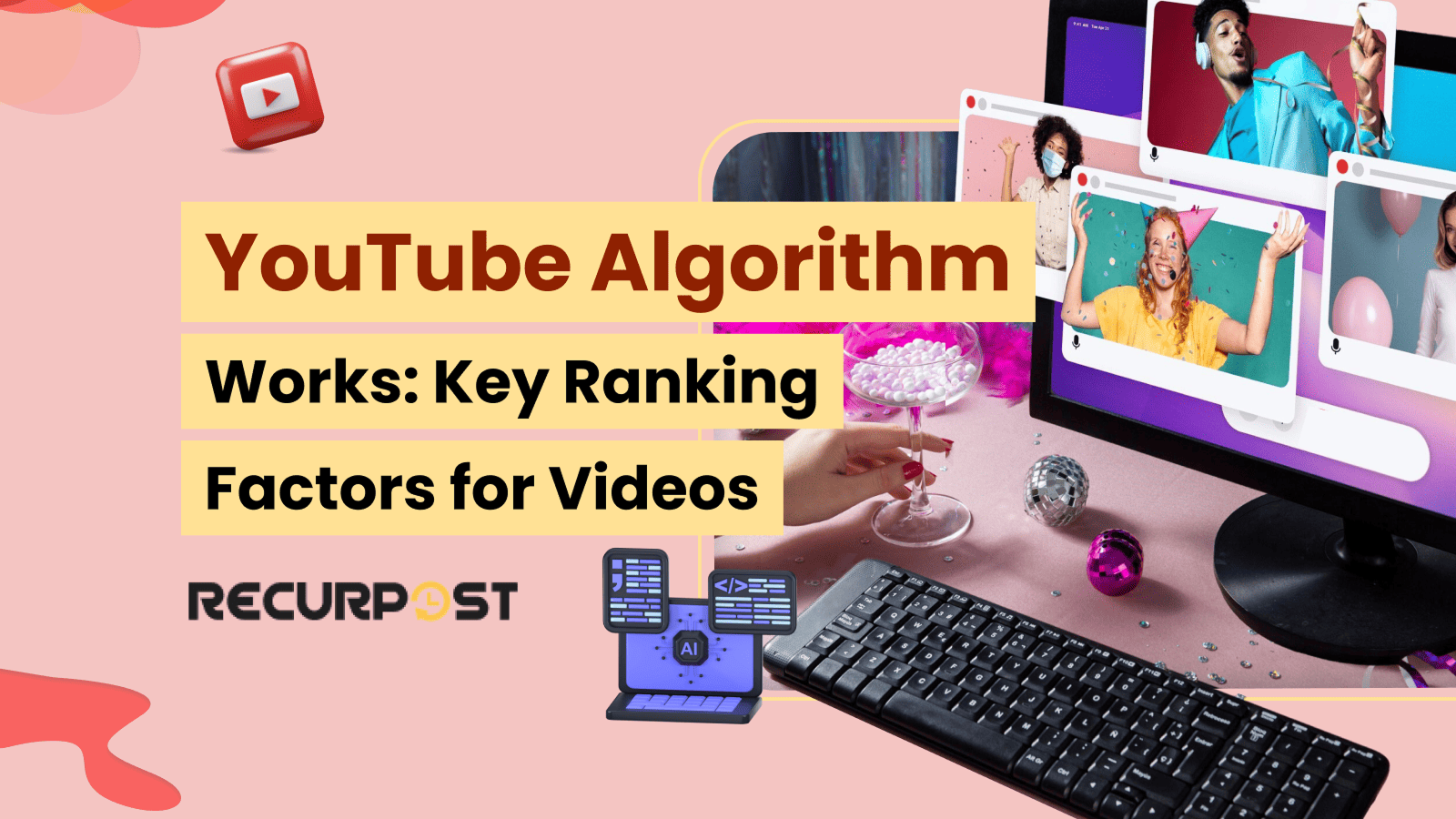The YouTube algorithm determines which videos appear on the homepage, the suggested videos feed, and the search results.
With over 2.7 billion users and thousands of videos uploaded every minute, standing out requires aligning your video content, titles, thumbnails, and descriptions with the algorithm’s priorities. The YouTube algorithm uses ranking factors including user behavior patterns, watch history data, engagement metrics like likes and comments, watch time duration, and click-through rates to rank videos and deliver personalized recommendations.
For creators and businesses, mastering YouTube SEO and how the algorithm for YouTube works is key to improving video rank, increasing visibility, and connecting with the right target audience on this competitive platform.
YouTube expands brand reach exponentially as a marketing platform. Optimizing content for this platform helps you stand out. This blog discusses how YouTube’s algorithm influences content discovery and shapes digital marketing strategies.
Did You Know?
70% of all views on YouTube come from YouTube algorithmic recommendations. (1)
How the YouTube Algorithm Works
The YouTube algorithm is a system that influences what content appears in front of users. It uses multiple factors, including user preferences, engagement patterns, and content metadata, to decide which videos are recommended to viewers. This keeps the platform engaging and personalized for each individual, driving higher user retention and engagement.
The YouTube algorithm shapes recommendation areas to present content aligned with individual preferences, ensuring higher engagement.
Discovery Paths
YouTube’s algorithm operates through different discovery paths that affect visibility, where the recommendation system uses multiple pathways to surface content to users.
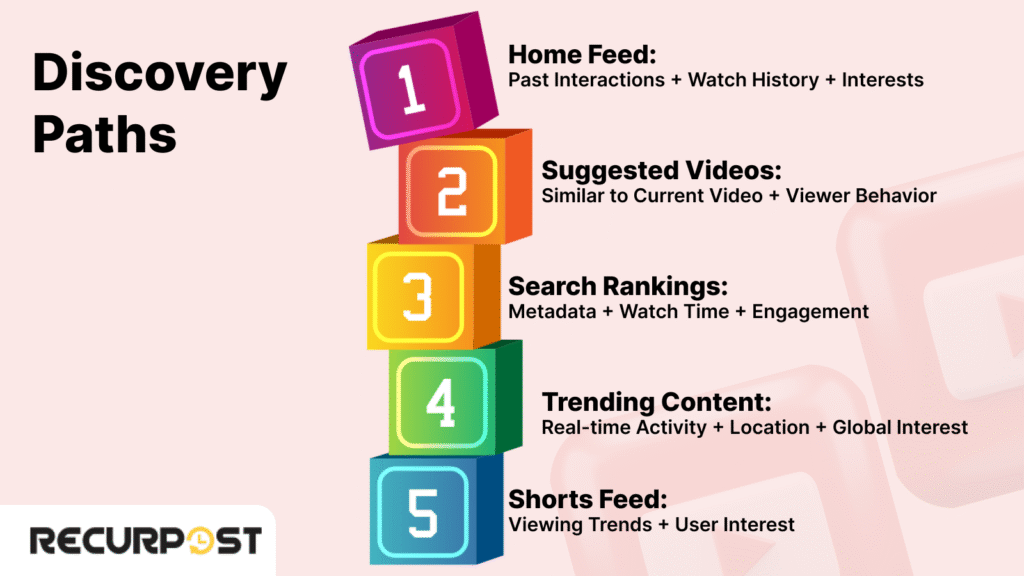
- Home Feed: Personalized based on past interactions, watch history, and interests.
- Suggested Videos: Shown alongside the current video, based on similarity and viewer behavior.
- Search Rankings: Videos ranked for relevance based on metadata, watch time, and engagement.
- Trending Content: Curated popular videos based on real-time activity, location, and global interest.
- Shorts Feed: Short videos recommended by viewing trends and user interest.
Personalization and Machine Learning
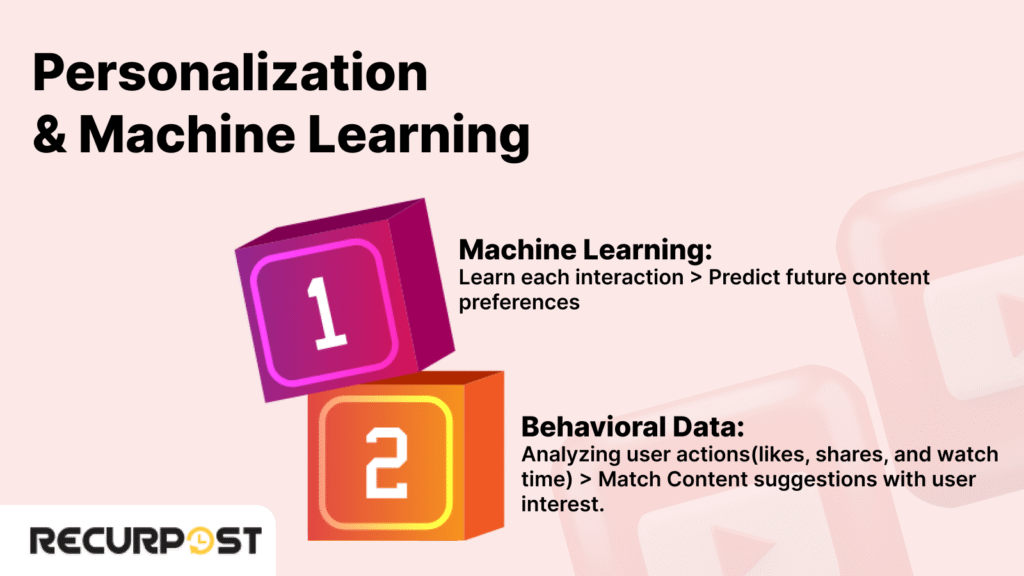
YouTube’s machine learning affects video recommendations by continuously learning from billions of daily interactions, where the system analyzes watch patterns, clicks, likes, and session duration to create personalized content feeds. This adaptive system delivers YouTube videos that align closely with their preferences, improving engagement and satisfaction.
The system uses machine learning to continuously adapt to the viewing habits of users. This personalized approach delivers content based on what users have watched previously, their preferences, and even demographic factors.
- Machine Learning: This allows YouTube to learn from each interaction and predict future content preferences, continually improving the recommendations.
- Behavioral Data: By analyzing user actions such as likes, shares, and watch time, YouTube adapts its content suggestions to match user interest.
Example: A user who frequently watches cooking videos will see more content related to recipes, cooking tips, and food reviews in their feed, based on the YouTube algorithm’s understanding of their interests.
Ranking Signals & Core Components
The YouTube algorithm uses key ranking signals and core components that prioritize videos based on signals reflecting viewer interest, where watch time, engagement metrics, and click-through rates serve as primary ranking factors.
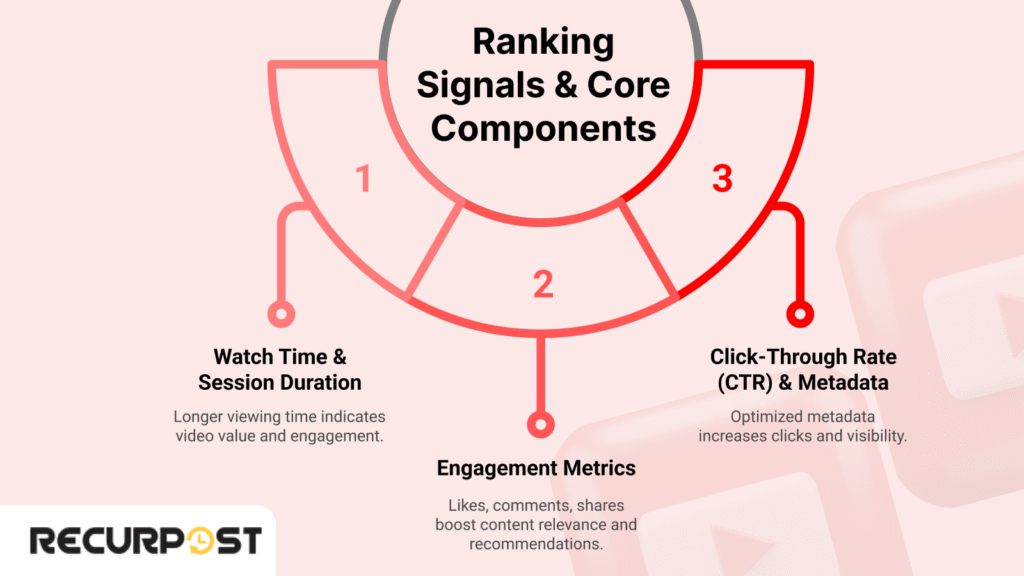
- Watch Time & Session Duration: Watch time and engagement play a central role in the YouTube algorithm because longer viewing indicates content value, while engagement metrics like comments and shares signal relevance to the recommendation system. Videos that keep viewers engaged, especially within thematic playlists and perform better in suggested videos and YouTube search results.
- Engagement Metrics: Likes, comments, shares, and subscriptions signal content relevance, increasing recommendation likelihood.
- Click-Through Rate (CTR) & Metadata: Click-Through Rate (CTR) & Metadata: Optimized video titles, descriptions, tags, and thumbnails increase clicks, boosting visibility on homepage, suggested videos section, and YouTube search results.
Example: Videos with engaging thumbnails and titles that drive high CTR tend to be promoted more widely.
Strategies to Increase Watch Time:
- Hook Viewers Early: Capture attention within the first 10-15 seconds with strong openings that tease value or key moments in videos.
- Maintain Pacing and Energy: Avoid slow starts or long intros, causing viewers to click away. Keep video content engaging throughout.
- Deliver on Title and Thumbnail Promises: Make your video’s title and thumbnails accurately reflect the content. Meeting viewer expectations leads them to watch till the end.
- Storytelling: Use a compelling narrative to keep viewers invested and watching more, increasing overall video watch time.
Impact on Visibility, Growth, and Key Metrics
YouTube decides which videos to display based on a combination of signals that influence visibility and growth potential.
Organic Reach & Content Visibility
The algorithm for YouTube evaluates multiple factors to determine which videos get shown and which remain hidden. The YouTube algorithm impacts video visibility and channel growth by evaluating early engagement signals such as likes, comments, and shares, which boost a video’s reach across the platform’s recommendation systems. These interactions send a signal that the content resonates with viewers, encouraging the algorithm for YouTube to promote it more widely.
Building Channel Authority
Building a strong YouTube channel reputation depends on consistently engaging your audience and delivering quality content that keeps viewers returning. YouTube Channels that maintain regular interaction and viewer interest earn trust from YouTube, leading to better placement within search results and recommendations.
SEO for YouTube
Optimizing video titles, descriptions, and tags increases content’s appearance in YouTube search results and suggested videos. Clear, relevant metadata helps YouTube match videos with viewers searching for related topics.
Quantitative Metrics That Shape the Algorithm
- Over 20 million videos are uploaded daily on average.
- Total uploads exceed 20 billion videos.
- YouTube Shorts receives over 70 billion daily views.
- The platform is available in 100+ countries and supports 80 languages.
This scale means the YouTube algorithm relies heavily on measurable signals to decide which videos deserve greater exposure. (2)
Optimize Content for the YouTube Algorithm
Videos get noticed on YouTube through more than just good content. How your videos are presented and how viewers engage with them play a major role in how often they appear to others. Here’s how to align your content with what the algorithm for YouTube favors:
How Metrics Affect Content Performance
- Watch time, click-through rate (CTR), and engagement impact video recommendations.
- Videos that keep viewers watching longer and encourage interaction perform better.
- Content tailored to improve these metrics supports steady growth and visibility.
YouTube SEO
- Use clear, relevant titles, descriptions, and tags to appear in YouTube search and suggested feeds.
- Create eye-catching thumbnails matching video content without misleading viewers.
Engagement-Driven Content
- Include calls-to-action (CTAs) encouraging likes, comments, shares, and subscriptions.
- Capture viewer attention within the first seconds to increase retention.
Increasing Session Duration
- Organize videos into playlists to encourage watching multiple videos in one session.
- Structure videos to maintain interest and flow, encouraging longer viewing times.
How YouTube Personalizes Content
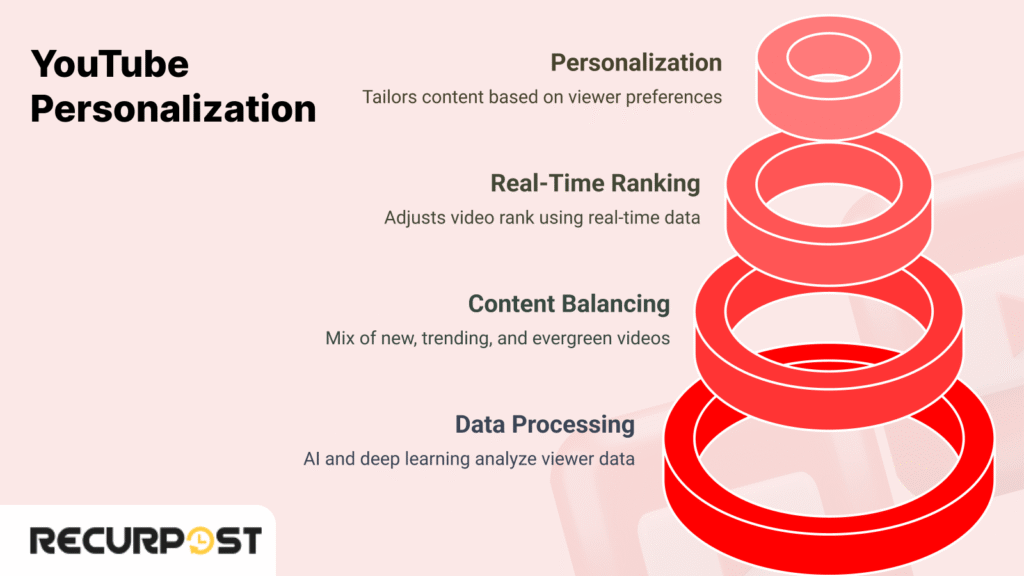
YouTube personalizes content for individual users through its recommendation system that uses advanced AI and deep neural networks to process watch history, interests, demographics, and viewing time patterns to tailor or personalize the homepage, suggested videos feed, and YouTube search results, improving viewer satisfaction.
The algorithm evaluates billions of interactions daily, refining predictions based on real-time data, including likes, comments, and watch time.
Machine Learning and Deep Learning Models
The YouTube algorithm processes billions of interactions daily using machine learning. YouTube adapts recommendations to viewer preferences and watch history, improving the prediction of videos resonating with individual users. Likes, comments, and watch time are evaluated in real time to refine predictions.
Balancing Freshness & Popularity
The YouTube algorithm balances freshness and popularity in recommendations by weighing new videos against trending content and evergreen popular videos, where this balance ensures viewers discover both current trends and timeless content that remains valuable over time. With over 500 hours of video uploaded every minute, this balance ensures that viewers discover both current trends and content that remains worth watching over time.
Real-Time Ranking & A/B Testing
YouTube’s ranking system adjusts using real-time data and A/B testing to improve video rank and recommendations. Creators use YouTube Analytics to monitor video performance, including click-through rate (CTR) and engagement, optimizing video titles, thumbnails, and content to reach target audiences.
Real-World Case Study: Gymshark’s YouTube Success

Businesses can leverage the YouTube algorithm for marketing success by creating engaging content that encourages longer watch times, collaborating with influencers to reach wider audiences, and optimizing for metrics like click-through rates and engagement.
As demonstrated by Gymshark, a UK-based fitness apparel brand that has effectively leveraged YouTube to expand its global presence. By aligning its content with YouTube’s algorithm, Gymshark has enhanced its visibility and engaged a broader audience.
Gymshark’s Approach to Leverage the Algorithm for YouTube
- Engaging Content Creation: Gymshark produces workout videos that resonate with fitness enthusiasts, encouraging longer watch times and higher engagement.
- Influencer Collaborations: The brand partners with fitness influencers to reach a wider audience and build credibility within the fitness community.
- Optimization for Key Metrics: Gymshark focuses on improving click-through rates (CTR), watch time, and engagement metrics to enhance its content’s performance on the platform.
Stat: As of May 13, 2025, Gymshark’s YouTube channel boasts over 720,000 subscribers.
Takeaways for Other Brands
- Aligning Content with Algorithmic Signals: Creating content that encourages viewer interaction and retention can improve visibility on YouTube.
- Collaborating with Influencers: Partnering with influencers can help brands reach new audiences and build trust within their industry.
- Focusing on Key Performance Metrics: Monitoring and optimizing metrics like CTR, watch time, and engagement can lead to better content performance and audience growth.
Stay Ahead of YouTube Algorithm Changes
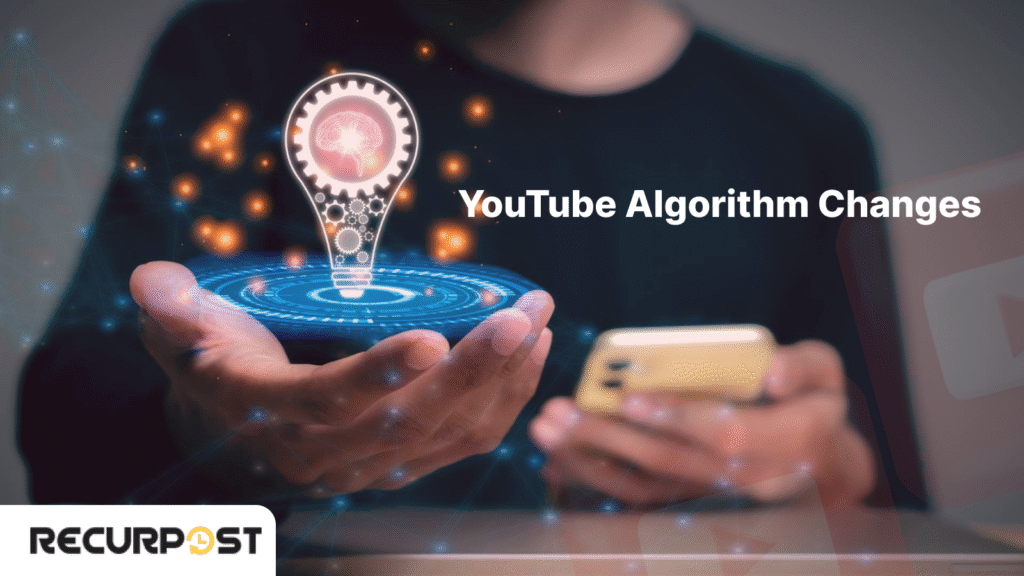
Creators can stay ahead of YouTube algorithm changes by following official announcements, monitoring analytics for performance shifts, experimenting with diverse content formats, and maintaining consistent uploads with optimized metadata, since the YouTube algorithm constantly evolves to deliver the most relevant YouTube videos to each viewer based on user behavior, watch history, and viewer satisfaction.
Staying informed about these changes helps YouTube creators optimize their video content for better video rank, increase video views, and greater reach on the video platform.
Key steps to stay ahead of updates and boost your channel growth:
- Follow official YouTube announcements to learn how the algorithm works and what affects ranking videos on the homepage, suggested videos feed, and search results.
- Track industry news on social media platforms and social media algorithms to spot trends in YouTube trending videos and viral video strategies.
- Use YouTube Analytics to monitor watch time, click-through rate (CTR), and engagement metrics to evaluate video performance and audience response.
- Experiment with diverse formats like YouTube Shorts, long-form videos, and new videos to see what resonates best with your target audience.
- Upload consistently and update your video’s title, video description, and create YouTube thumbnails optimized for YouTube SEO to improve click-through rate and discoverability.
- Include relevant keywords related to your video’s topic to boost visibility in YouTube search results and the suggested videos section.
- Encourage viewers to interact with the subscribe button and watch related videos or thematic playlists to increase video watch time and session duration.
- Analyze personalized video suggestions and how similar viewers engage with popular videos to tailor your content for better user engagement.
Aligning your strategy with the evolving YouTube algorithm maximizes channel growth, improves video rank, and deepens connections with the YouTube audience.
To Sum Up
The YouTube algorithm rewards content that builds genuine connections with the YouTube audience. Beyond chasing YouTube trending videos or boosting video views, success lies in creating video content that sparks curiosity and holds attention. When you focus on what your target audience truly values, your YouTube channel grows through meaningful engagement and higher watch time. Creativity and adaptability help navigate the YouTube algorithm and shape a lasting presence on this evolving platform.
Frequently Asked Questions
1. What is YouTube’s current algorithm and how does it work?
YouTube’s algorithm uses machine learning to recommend videos based on user behavior, watch history, engagement, and video metadata. It prioritizes videos that keep viewers watching longer and interacting through likes, comments, and shares, personalizing content for each user.
2. How can I improve my ranking on the YouTube algorithm?
Focus on increasing watch time, click-through rate (CTR), and engagement. Create compelling thumbnails and titles, keep viewers hooked early, deliver content that matches expectations, and encourage likes, comments, and subscriptions to boost your visibility.
3. Does YouTube pay creators based on views? How much is 1000 or 50,000 views worth?
YouTube monetizes views through ads, and payment varies by factors like audience location and engagement. On average, creators earn about $0.88 to $2.90 per 1,000 views, so 50,000 views could earn roughly $44 to $145, but results differ widely.
4. How important is video quality like 4K for YouTube’s algorithm?
While high-quality 4K videos enhance viewer experience, YouTube’s algorithm prioritizes engagement and watch time over resolution. Great content that keeps viewers watching matters more than just video quality.
5. What are the top strategies to beat the YouTube algorithm and go viral?
Create content tailored to your audience’s interests, optimize SEO with relevant keywords, maintain consistent uploads, engage viewers early, and use playlists to increase session duration. Also, experiment with trending formats like Shorts to boost viral potential.

Ruchi Dhimar is a skilled content writer with 4 years of experience. She is passionate about crafting compelling narratives, specializing in writing content for different industries.
